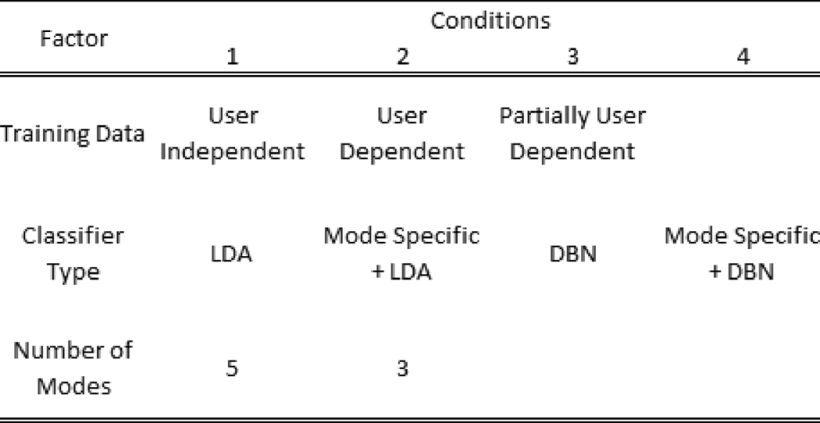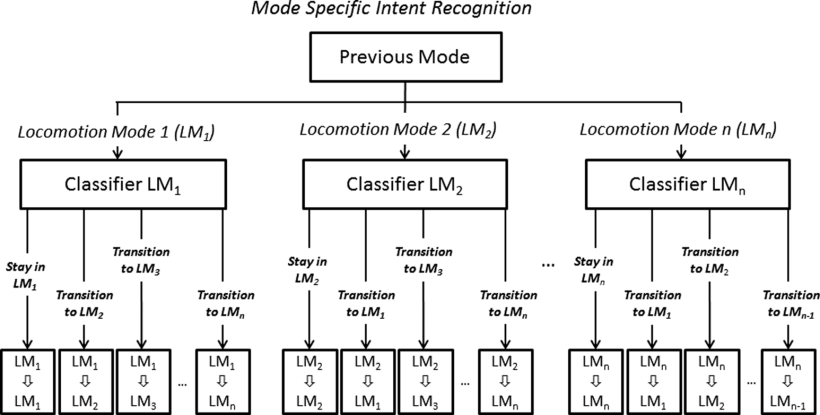A Classification Method for User-Independent Intent Recognition for Transfemoral Amputees Using Powered Lower Limb Prostheses
intention定义—locomotion modes: level walking, ramp ascent, ramp descent, stair ascent, and stair descent
Research question
to develop a user-independent intent recognition system capable of recognizing level-ground walking, slopes, and stairs and to compare this system with a user-dependent intent recognition system.
Introduction
- Prior studies in which pattern recognition algorithms: current methods to initiate transitions between modes, such as visual, audio, or compensatory movement commands, are unintuitive and impose a cognitive burden. An inherent disadvantage of pattern recognition-based intent recognition systems is that a considerable amount of training data must be collected.
- previous able-bodied gait studies with accelerometer data: by pooling data from a large subject group(e.g. n = 52), high accuracies (~96% ) of gait mode identification for a novel subject can be obtained for level-ground walking, slopes, and stairs. In addition, to obtain these high accuracies for novel subjects, group gait features were normalized to the novel subject’s level-ground walking data.
Methods
-
Experimental testing factors

-
training and testing: A group of eight transfemoral amputees walked over different terrains using a powered knee and ankle prosthesis. We created a pooled classifier using data from all subjects except one: data from this single subject was withheld from the pool and used to test how well the pooled classifier generalized to that subject in an offline analysis.
-
the partially-dependent classification system: including data from some of the novel subject’s steady-state level-ground walking in the training pool, to determine whether generalization to that subject improved.
-
mode-specific: having a separate classifier active for each locomotion mode. The previous locomotion mode determines the classifier model used for predicting the next stop. Each “mode specific” classifier was trained using the steady-state locomotion mode, and only the relevant transitions leaving the current locomotion mode. This enabled each transition to be statistically classified as a separate class, and to only be considered at the appropriate times.

-
DBN: dynamic Bayesian network
-
LDA: linear discriminant analysis (LDA)
-
- Experimental Protocol
- Signal Processing
- Sensors: potentiometers and encoders at the knee and ankle, an axial load cell, and a six-axis IMU on the shank; Sensor signals were generated for knee and ankle positions, velocity and torque, axial force, and shank three-directional accelerations and rotational velocities.
- normalization; 数据迁移到另一侧截肢的被试
- 划窗 segmented into analysis windows of 300ms at eight different points for each stride
- 特征提取 From each analysis window, six features were extracted: the signal mean and standard deviation, the minimum and maximum signal values over the window, and the starting and ending signal values
- Signal Classification Strategies
- Baseline Configuration: LDA
- Time History Configuration: DBN to integrate information over the gait cycle to include time history (TH) information.
- Mode-Specific Configuration
- Mode Specific + Time History Configuration
- Classification Procedure
- Performance Evaluation
- intent recognition error rate, averaged across all steps for each subject, as our primary performance metric.
- statistical analyses
- two-way ANOVAs transitional and steady-state errors with subject as a random factor. Classification condition (user-independent, partially dependent, and user-dependent) and classifier configuration were included as fixed factors.
- a post hoc Bonferronni test on significant factors to determine specific differences ($\alpha$=0.05).
Results
For both user-dependent and user-independent classification, mode-specific classification reduced error (p < 0.05) on transitional steps by 50 without affecting steady-state classification. Incorporating sensor time history and level-ground walking data from the novel subject into the training data resulted in decreasing errors (p < 0.05) on steady-state classification by over 60% without affecting transitional error.
Thoughts/Comments
- 为什么partially-dependent 可以判断generalization to that subject是否improve